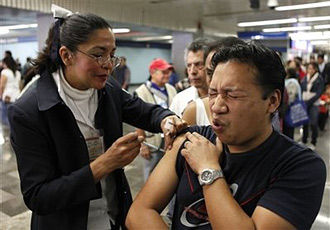Pandemic Easing, Risk Remains
 Stephanie Nebehay - Reuters Stephanie Nebehay - Reuters
go to original
January 19, 2010


| | A man is vaccinated against swine flu by a nurse in a subway station in Mexico City, Monday, Jan. 18, 2010. Mexico City government started on Monday a vaccination program against swine flu. (AP/Eduardo Verdugo) |  |
Geneva - The H1N1 flu pandemic appears to be easing, but a third wave of infections could yet strike, the World Health Organization (WHO) said on Monday.

“Pandemic infections are occurring in many countries but overall the pattern is decreasing,” Keiji Fukuda, the WHO's top flu expert, said at the start of a week-long meeting of the organization's Executive Board.

He warned, however, that a new wave of infections could hit the northern hemisphere in late winter or early spring, saying: “This is probably the biggest speculation. We simply do not know.”

The H1N1 virus, also known as swine flu, emerged last April and caused the first influenza pandemic in 40 years. It initially sparked widespread concern about antiviral and vaccine supplies, especially in developing countries, but many nations have cut back their vaccine orders recently because the pandemic has not turned out as deadly as originally feared.

WHO director-general Margaret Chan told the meeting that the effects of the pandemic had been moderate and were probably closer to outbreaks experienced in 1957 and 1968 rather than the far more deadly 1918 version.

The 1918 pandemic, known as the Spanish flu, swept around the world at the end of World War One, killing some 40-50 million people.

Chan said H1N1 appeared to be easing in the northern hemisphere, but cautioned that it was too soon to say what would happen once the southern hemisphere entered winter. |



